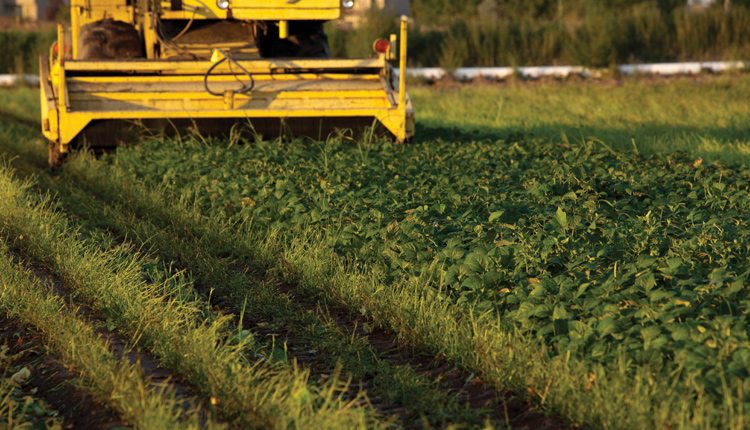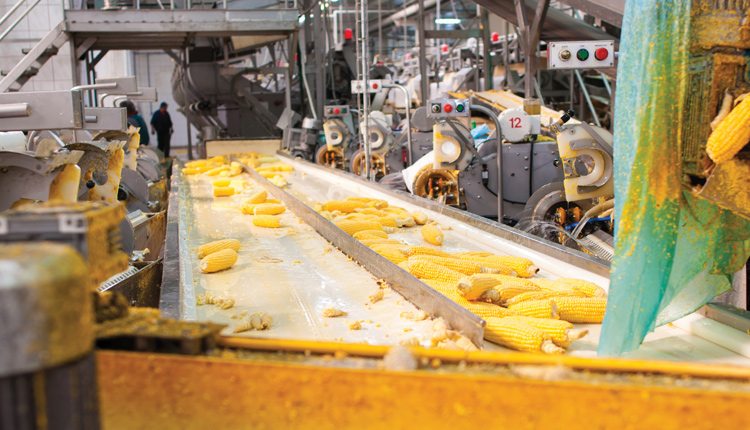Plant breeding trends are affecting changes in food processing equipment and processes.
Food processing equipment manufacturers are increasingly under pressure to alter designs of large-scale machinery to accommodate new varieties of fruits and vegetables developed through plant breeding. At the same time, increased consumer demand for fresh market, organic and ethnic produce is creating a need for more flexible and smaller versions of standard food processing equipment.
The scenario requires a balancing act for food processing equipment manufacturers – who need to satisfy large commercial processors’ needs for ever greater operating efficiency with the increasingly important small processing operations that serve niche markets, says Ross Lund, president of Hughes Equipment Company.
“Food processing equipment manufacturers need to pay close attention to changing market trends and continue to follow advances in plant genetics. As characteristics of crops are changed, as new crops are being introduced and as some market sectors favor less processing, equipment will need to be redesigned – or new equipment developed – to accommodate the changes,” Lund says.
Advances in technology and practice have increased plant breeding efficiency as well as plant breeding possibilities that allow growers to meet more diverse market demands.
Emphasis on Increased Yield
In the 20th century, the innovational emphasis in plant breeding, agricultural research and farming practices was on increasing yield – the size of vegetables, number of vegetables per plant, increased holding capacity, recovery, etc.
“Ears of sweet corn have continually increased in size over the last 30 years to the point they are on the upper limit of fitting in current processing machinery,” notes Todd Belz, director of engineering at Hughes Equipment Company.
The combination of mechanization and the ever improving research in plant breeding and agronomy has led to a greatly increased crop yield, while the related standardization of produce has supported a significant increase in the speed and efficiency of harvest and production. Efforts to increase yield to an even higher degree remain a priority in the commercial crop market. Plant breeding, supported by modern molecular genetics, remains central to those efforts.
“For the most part, 50 percent of the gain [in the yield of modern crops] is due to genetic improvement in breeding,” according to William F. Tracy, professor and chair of agronomy and the Friday Endowed Chair of Vegetable Research at the University of Wisconsin-Madison.
Multiple Benefits from Plant Breeding
However, in addition to that direct relationship, plant breeding also allows for improvements in other areas.
“The old fashioned plants could not handle the high intensity agronomy that we do today; in other words, the old fashioned plants could not handle high fertility, high irrigation, high population density without failing. So in many crops it’s a hand-in-hand situation,” he adds.
Tracy sees no slowdown in plant breeding for most crops.
“I don’t think many of the vegetable crops have had enough improvement to start leveling off yet,” he notes.
Despite modern advances in plant breeding practices, geneticists can only do so much with one variety of plant. Breeders must still prioritize desired traits for specific plants, as some traits are simply incompatible.
“The classic example of competing traits is as we try to increase quality, have it more tender and sweeter, that clearly decreases yield. You’re not going to find the highest quality with fabulous germination,” Tracy says. “That’s just not the way it’s going to happen because the thing that germinates the seed is actually what we eat, so when we try to make it higher quality, we are essentially inevitably selecting for poorer germination.”
Only certain desirable characteristics can be bred for and maximized together, leading to a divergence in plant breeding goals to satisfy market demands for types of traits.
Drivers for Commercial Processors
Higher yield remains a major priority in the breeding of commercial crops. However, while yield is a primary concern for commercial processors, they must still deliver a product that fits within a flavor spectrum that the consumer will accept.
“Consumers have a flavor spectrum that they are looking for, and the processor is trying to meet that flavor spectrum, so we are trying to meet that flavor spectrum – but then the processor is also looking to be profitable, so we on the breeding side are looking at all components that can increase the profitability or reduce waste (for) the processor,” says David Fischer of HM.CLAUSE, which is part of Limagrain, an international agriculture cooperative based in France and the fourth largest seed company in the world.
Breeding for higher yield and reduced waste involves selecting for a number of specific traits. One of those traits is the increased size of the vegetable itself.
Tracy states, “Typically, because they are shooting for higher tonnage per acre, the [plants for processing] would be bigger.” In addition to increasing yield in and of itself, the increased size of the plants helps them better compete with weeds.
Using sweet corn as an example, Tracy explains, “Another very important thing is that bigger plants will compete better with weeds, and weeds are a big cost to all sweet corn growers. All farmers want weed control but (commercial) processors need it more.”
A harvest with fewer weeds increases yield and increases efficiency during processing. With fewer weeds, there is less wear on processing machinery, especially cleaning machines. There also could be less need for certain cleaning machines in the processing line.
Ripening Rate
Commercial crops are also bred for increases in holding capacity, as Tracy explains. “One of the things that processors have to worry about a lot is how long [that crop will] last out in the field before harvest. If it starts to go bad, or lose its quality too quickly, then that’s going to be a big loss to the processor.”
In their attempts to breed for desirable qualities, commercial processors often work closely with plant breeders.
“There have been examples of processors working with breeders to find varieties that fit the mechanical process better,” says Tracy. “Processors must take into account whether a mechanical picker can pick corn or whether processing machines can handle it. Different varieties that have many great characteristics are frequently thrown out because they don’t work for the processor.”
Maximizing yield, while ensuring the efficiency of their machines’ operations, remains the focus of commercial processors. The ever increasing demand for greater yield and, as Tracy suggests, the fact that plant breeding potential does not seem to be leveling off for the most part, has caused food processing equipment manufacturers to accept a process of constant adjustment and modification to their machinery.
Niche Market Trends
While plant breeding for increased yield and disease resistance continues, changing consumer preferences are also at play.
“There’s a lot stronger consumer emphasis on niche product,” Fischer notes. That includes organic produce as well as vegetables and fruits that cater to ethnic markets and the fresh market.
The modern organic movement is still getting its foothold in the plant-breeding realm and variety development is on a much different scale. Therefore, organic crops tend to be smaller, more difficult to harvest, and more laden with weeds and waste products when they are brought to be processed by organic processing methods.
Before the modern organic movement, the trend had been to “make the plants more robust and cleaner and easier to harvest,” notes Belz.
Today’s organic preferences tend to challenge those endeavors, necessitating innovation in food processing equipment to accommodate organic crops and the related processing methods.
Ethnic Market Specialization
The ethnic market is a trend of diversity and specialization states Belz. “If you go to Chicago you can almost draw on a map the different [ethnic zones], and they all have their own specific style of food. It’s a huge market with people who have a lot of buying power. They have a big say in what they buy and whom they buy it from.”
The significance of the increased ethnic diversity of food in terms of plant breeding is brought about by the market’s demand for plants that are not native to an environment where demand for a crop exists. Crops from different regions around the world and even the nation are obviously easier to obtain if they are conditioned to grow in local or closely neighboring regions. Therefore, to meet the niche demands of the ethnic market, plants are bred to be able to survive in non-native and numerous different growing conditions.
Breeding to make crops viable in other regions is a concern even for commercial processors. As Fischer states, “A sweet corn seed that performs well in one market, may not perform well in a different geographic market, and then the breeding company is going to have to decide whether the second market is going to be big enough to target … and decide whether it is a market it wants to put its resources toward.”
Smaller Machinery
While a market may need to be of a certain size to justify a commercial processor’s efforts, the ethnic market in the United States has created opportunity for those capable of – and content with – meeting niche demand with smaller food processing machinery. Those niche ethnic markets considered together make up an important food trend, and the ethnic market has incentivized the breeding of non-native plants to make them viable in areas closer to where the demand for those products exist.
Because demand within what can be called the ethnic market generally involves small, specialized pockets of demand, this demand is often met by smaller processors or growers who have taken on the additional role of being a producer. Ethnic market farmers often see this option as more profitable.
Fischer points out that on the fresh market side and potentially on the ethnic market side, the grower doesn’t have to work through the middleman of the processor. “The grower is directly in contact with the consumer, so on the fresh market and potentially on the ethnic side, the grower and the consumer are talking and making that decision about what they are looking for.”
As a consequence of being closer to the consumer, Belz says that: “There is a rapidly growing number of small businesses and farmers who have converted their growing operations to processing operations. Those small processors obviously do not require large industrial equipment, thereby creating a demand for miniature, low output processing machinery.”
Food Processing Equipment Solutions
Food processing equipment manufacturers are modifying and improving their product lines to accommodate these trends in market demand and the subsequent food breeding and farming practices designed to satisfy the various markets. As Fischer says, “That’s where the flexibility comes in for the food processing equipment side, as the processor starts trying to meet more of the niche markets to meet the demand of the consumer.”
Trends such as the organic movement require more cleaning and washing machinery, such as Hughes Equipment’s raw product air cleaner, which is designed to blow trash products and debris from the crops before they enter the rest of the processing line. Removing the excess debris alleviates stress on machinery used further along in the process.
Belz cites the traits of organic green beans are another example of the need for specialized processing machinery. “Organic green beans produce greater levels of unwanted extraneous material.”
As a result, organic green beans are transported to the processor with significantly increased volumes of clusters and residual plant material as opposed to being presented to the processor in individual pieces.
Fresh market processing often also demands smaller equipment to prevent product from being harmed during processing. Belz explains that in commercial processing, if a particular product is bruised during processing, the defect can often be made unnoticeable through the process of blanching. Blanching is not used in fresh processing; therefore, greater care is taken to prevent any such defects though the use of smaller, gentler machines, which processing equipment manufacturers are constantly tweaking to prevent product harm as much as possible.
Gentler, Lower Capacity Machinery
The fresh market and ethnic markets require low output processing machines for the purpose of damage control further supporting the trend toward miniaturization in equipment. To eliminate the cost of buying multiple machines, lower capacity markets also need their machines to be customizable and capable of running multiple kinds of vegetables. Belz sees increasing demand for nimble and flexible equipment, and sees a clear trend away from standardization to customization.
Plant breeding has been able to increase yield while lowering the amount of land needed for agriculture. Not only has it been able to increase the sheer number and tons of crops, it has been able to improve quality, taste and texture, as well as a plant’s ability to grow in a region that it did not originally inhabit.
Some markets have fully embraced the potential of plant breeding, while movements like the modern organic movement is still cautious. To accommodate both scenarios, food processing equipment manufacturers need to alter designs or come up with new machinery that can handle larger vegetables, crops that are not native to a region, and increased field trash in the processing stream.
















